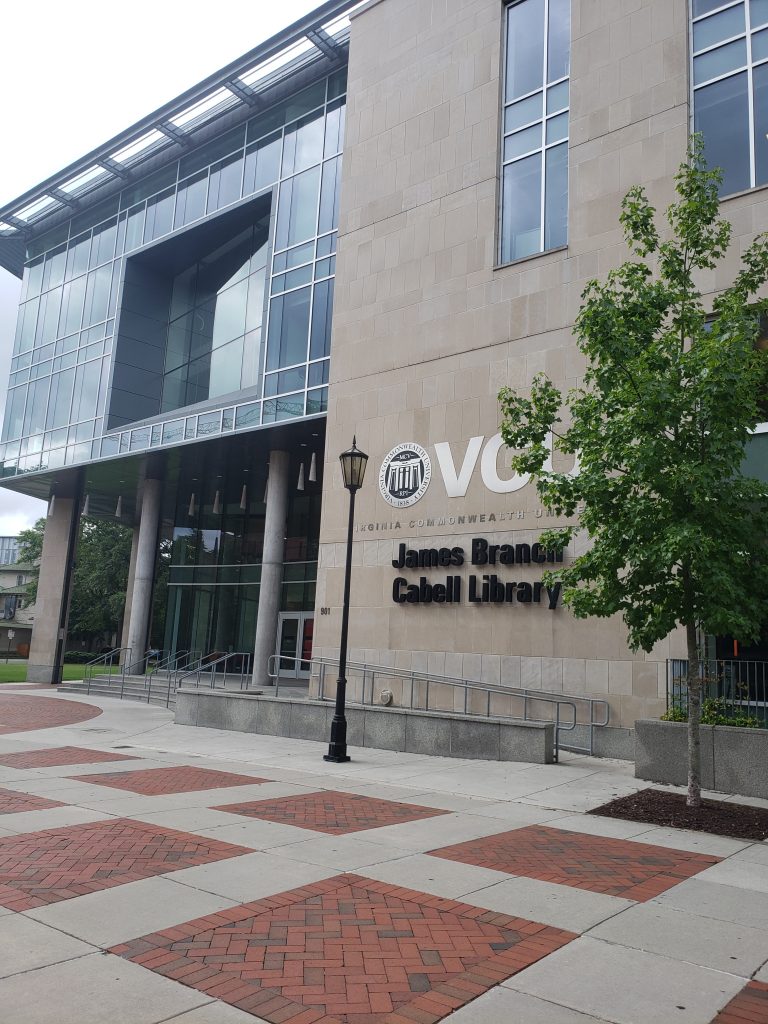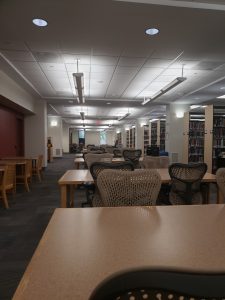Virginia Commonwealth University- James Branch Cabell Library

For the academic library visit, I went to the Virginia Commonwealth University(VCU) library. Their website can be found here. I found their website to be a bit more involved than the school and public library websites that I visited. However, after playing around on it for a while it wasn’t too bad. I do like how the search bar is always at the top so that you can search what you need at anytime. They also have the address, phone number, and hours clearly listed on the homepage. All of the staff members and their contact information is listed in the about us section of the webpage. There are many databases, journals, and collections which would be expected of an academic library. Rubin & Rubin (2020) tell us that “libraries provide access to collections sufficient in quality, depth, diversity, format, and currency to support the research and teaching missions of the institution” and from what I can see on the website, VCU library does just that (p.135). One thing that I found encouraging on the website was that they do have a diversity statement and within that statement they note their shortcomings and a plan for how to address them. According to their statement, “Our employees are not as diverse as the communities we serve, and we are currently developing policies and practices to help us recruit and retain a more diverse group.” (VCU, Diversity Statement).
I was fortunate enough to be able to conduct this visit with a fellow classmate, Kat Sharnoff. We were both able to find parking, but I did have to park about 2 blocks away. (However, it does seem to be accessible from the Richmond bus line.) We also noted many bike racks outside and were were able to use access the wifi from outside. However, Kat did notice that to use the wifi you were limited to a few minutes as a guest. You would have to have VCU credentials to log in and use it for any log amount of time. The building looked welcoming and did not seem to need any updating. Although, they were currently renovating to create more gender inclusive restrooms.
The library has 4 floors with ample signage and directories letting the patrons know where they could find what they were looking for. There were also numerous staff members that could help if needed. The 1st and 2nd levels had study areas, reference books, computers, copiers, and study rooms. The third floor is a quiet room where only whispering is allowed. The fourth floor is their designated silent area where there is no noise permitted at all. I did not visit the 4th floor while there as I had my daughter with me and wasn’t sure she could be silent. You can also access their map online to get a better sense of the layout. There are elevators available for those who can’t use the stairs.

Seating areas
The library catalog was accessible on the computers provided, however you would need VCU credentials to access them. You are able to get temporary credentials from the information desk if you are not a student or staff at VCU. The reference materials were organized by the subject area and use the Dewey Decimal system. Judging by their diversity statement and who I saw in the library, it did seem that everyone is welcome of all races and abilities. However, it did not seem that children were welcome. When we first entered into the building, there was a security guard who questioned what were doing in the library and asked to see our identification. The she made a general comment about how people don’t normally bring children in there and personally made me not feel welcomed. However, the website does mention that the library is open to the public so I’m not sure what the reasoning for the accosting was. Both Kat and I agreed that it felt a bit strange, especially since the security would periodically walk by and “check on us” and it didn’t seem that she was doing that to other patrons.
This is clearly an academic library as the majority of the books I saw on the first floor were reference books, government documents, and academic journals. This makes sense as most universities “tend to serve research and graduate programs” (Rubin & Rubin, 2020, p. 135). Some of the special items that I noticed was a video magnifier so that you could read smaller print easier, many scanners, an oversized book area, an artbook collection, a section on juvenile and youth books, as well as many digital exhibits and projects. There was also a makerspace area.
Overall, this visit reminded me of my undergrad days and studying in the library. It surprised to me to see a huge Starbucks attached to the library. I don’t know that I have ever seen that before and would have liked that at my undergrad library. Nothing really disappointed me, but I didn’t feel like my daughter was welcomed there even though she was very well behaved. Being summer, I didn’t see a lot of interaction of the staff with the patrons/students, and so that is something that I would like to see more of and learn more about. It would be interesting to see what all the librarians do to help the students.
Rubin, R. E., & Rubin, R. G. (2020). Foundations of library and information science (5th ed.). ALA Neal-Schuman
VCU. (2022) Diversity statement. VCU Libraries. https://www.library.vcu.edu/about/diversity/
Leave a Reply to Abby Scheetz Cancel reply